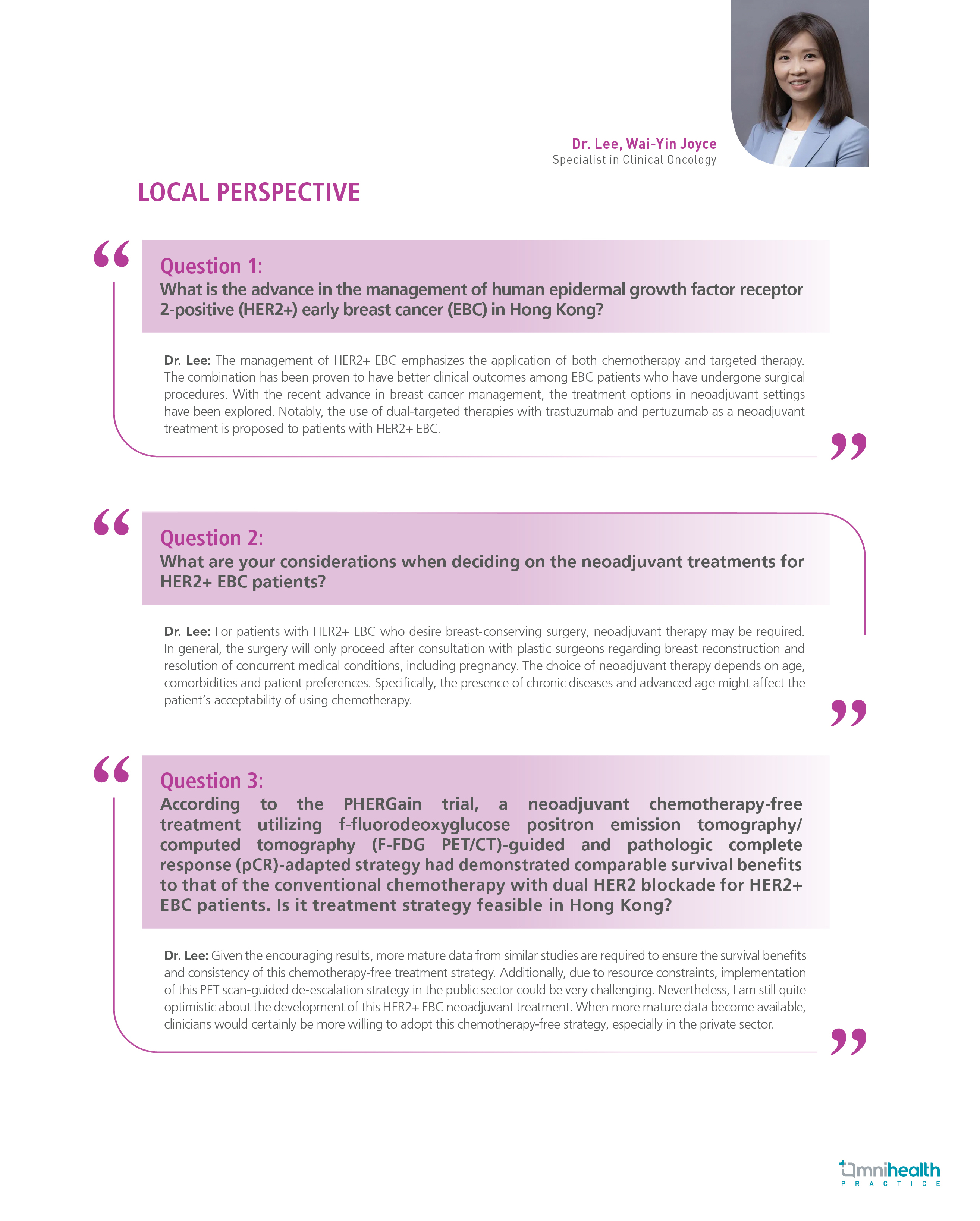CONFERENCE UPDATES: ASCO 2023
The impact of PET scan-guided de-escalation strategies on 3-year IDFS in HER2+ EBC patients
The clinical outcomes for human epidermal growth factor receptor 2-positive (HER2+) early breast cancer (EBC) have been significantly improved since the emergence of HER2-directed therapies.1 Utilizing f-fluorodeoxyglucose positron emission tomography/computed tomography (F-FDG PET/CT), de-escalation strategies of HER2-directed chemotherapies can be proposed based on the resulting metabolic responses, thus ensuring a higher probability of pathological complete response (pCR).1 In the 2023 ASCO Annual Meeting, Dr. Javier Cortés from International Breast Cancer Center (IBCC), Barcelona, Spain, shared the analysis results of 3-year invasive disease-free survival (IDFS) from the PHERGain trial, further demonstrating the positive impact of the aforementioned treatment interventions.1
The PHERGain trial is a strategy-based randomized phase 2 trial that investigated the practicality of chemotherapy de-escalation for HER2+ EBC patients based on pathological and early metabolic responses observed in F-FDG PET/CT towards a neoadjuvant combination therapy of trastuzumab and pertuzumab (HP).1 A total of 356 patients with confirmed HER2+ stage I to IIIA EBC, a tumor diameter of ≥1.5cm and evaluable PET breast lesions were randomized 1:4 into 2 groups.1 Group A (n=71) received chemotherapy until surgery (cycle 8), then switched to a combined therapy of HP and endocrine therapy (ET).1 Group B (n=285) received HP with ET if applicable for 2 cycles (6 weeks) with PET total body scans conducted before and after the 2 cycles of treatment to detect early metabolic responses.1 Patients who showed early metabolic responses continued the combined HP-endocrine treatment until surgery, while patients who showed no metabolic responses were switched to chemotherapy until surgery.1 After surgery, PET responders with pCR continued the combined HP-endocrine treatment and PET responders without pCR switched to chemotherapy, while PET non-responders returned to the combined HP-endocrine treatment during the follow-up period.1
The primary endpoints of this analysis were the pCR rates of PET responders in group B and the overall 3-year IDFS rate in group B with statistical considerations based on a one-sided exact binomial test (H0: pCR ≤20%; 3-year IDFS ≤89%).1 The secondary endpoints included safety assessment, 3-year IDFS of group A, 3-year distant disease-free survival (DDFS), event-free survival (EFS), and overall survival (OS) of both groups.1
The results of group B were impressive, with a median follow-up period of 3.5 years, a pCR rate of 37.9% (95% CI: 31.6%-44.5%; p<0.001), PET responders accounting for 79.6%, and a remarkable 3-year IDFS rate of 95.4% (95% CI: 92.8%-98.0%; p<0.001), where relapse and non-related death without recurrence had an incidence rate of 4.1% and 0.4%, respectively.1 In addition, a notable 3-year IDFS rate of 98.8% (95% CI: 96.3%-100%) was found among PET responders with pCR (n=86), who did not receive any chemotherapy throughout the study.1
The secondary endpoints for groups A and B showed similar results across the various efficacy measures over the 3-year follow-up period without significant differences (IDFS: 98.3% vs. 95.4%; DDFS: 98.3% vs. 96.5%; EFS: 98.4% vs. 93.5%; OS: 98.4% vs. 98.5%).1 This indicated that the efficacy of the combined HP-endocrine treatment was comparable with the conventional chemotherapy.1
In terms of safety, the incidence of grade 3 or 4 treatment-emergent adverse events (TEAEs) was significantly lower in group B (32.9%) than in group A (61.8%).1 Furthermore, for chemotherapy-free PET responders with pCR, the incidence of grade 3 or 4 TEAEs in group B was remarkably low at only 1.2%, demonstrating the excellent tolerability of chemotherapy-free combined HP therapy.1 The treatment-discontinuation rates were also low in both groups A and B, standing at 8.8 % and 2.1%, respectively.1 No deaths were recorded throughout the study.1
In conclusion, the PHERGain study demonstrated that chemotherapy-free therapy possessed similar efficacy and reduced toxicity to the conventional chemotherapy options in the HER2+ EBC treatment.1 Furthermore, the metabolic responses from F-FDG PET/CT scans can serve as reliable indicators to de-escalate the use of chemotherapy, thus increasing the odds of achieving pCR.1



